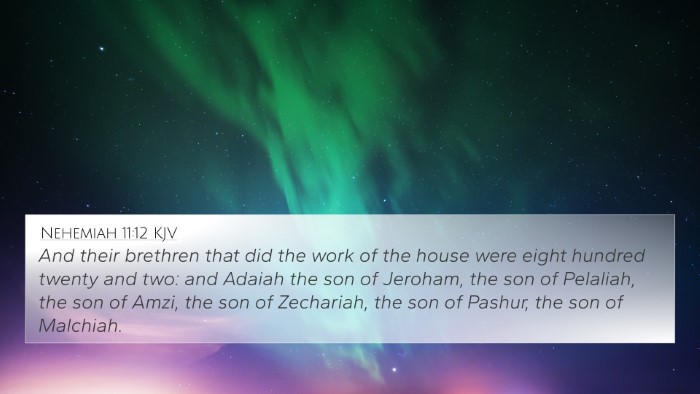Understanding Nehemiah 10:3
Nehemiah 10:3 states, “And Aholiah, the son of Abishua, the son of Phinehas, the son of Eleazar, the son of Aaron, the priest, and the Levites, and their brethren.” This verse highlights the lineage of those involved in the covenant renewal process during Nehemiah's time. Below is a comprehensive exploration of its meaning, drawing insights from various public domain commentaries.
Context of Nehemiah 10:3
The Book of Nehemiah documents the return of the Jewish exiles from Babylon and the reconstruction of Jerusalem's walls. The chapter aims to reaffirm the covenant between God and the Israelites, showcasing their commitment to follow God's laws. The mention of priestly lineage emphasizes the importance of priesthood in maintaining the covenant community.
Commentary Insights
- Matthew Henry's Commentary:
Matthew Henry emphasizes the significance of the covenant renewal led by Nehemiah. He notes the mention of the priesthood, which signifies God's intention to keep His people close through His appointed servants. The lineage points not just to family heritage but God’s longstanding covenant with the descendants of Aaron.
- Albert Barnes' Notes on the Whole Bible:
Barnes highlights that the genealogical references serve to authenticate the religious practices of the Jewish people. He explains that the Levites mentioned played a crucial role in the worship and sacrifices, bringing a sense of continuity and legitimacy to the religious activities following the exile.
- Adam Clarke's Commentary:
Clarke describes how the mention of priests in the covenant shows the seriousness with which the people viewed their identity after returning from Babylon. It signifies restoration and perseverance in tradition, reflecting the Israelites’ desire to adhere to God's commands as expressed through their ancestry.
Thematic Connections
This verse can be connected with several key themes found throughout scripture, especially regarding covenant renewal, priestly responsibility, and the continuity of faith. Below are some thematic connections:
- Covenant and Commitment: Nehemiah 10 relates closely to Deuteronomy 29, which emphasizes the importance of remembering and adhering to the covenant with God.
- Priestly Lineage: Exodus 28 and Leviticus 8 provide insights into the significance of the priesthood and their duties, which echo through to Nehemiah's time.
- Restoration of Worship: Ezra 3 includes the rebuilding of the altar and the foundation of the temple, linking back to the community's religious revival.
- Historical Record: 1 Chronicles 6 discusses the genealogies of the priestly lines, establishing a foundation for Nehemiah’s narrative.
- Faithfulness Across Generations: Hebrews 7 compares the priestly system, indicating the continuity from Aaron through Christ as the ultimate priest.
Bible Cross-References
Here are some pertinent cross-references that enhance the understanding of Nehemiah 10:3:
- Exodus 28:1: God’s command to appoint Aaron and his sons as priests.
- Leviticus 10:6: Reinforcement of the holiness of the priesthood and its duties.
- Deuteronomy 10:8-9: The establishment of the Levites as priests unto God.
- Nehemiah 8:9: The role of priests in teaching the Law during the time of Ezra.
- Hebrews 5:4: Discussion on the appointment of priests, indicating the divine choice in leadership.
- Jeremiah 33:20-21: The promise of a lasting covenant with David, impacting the priestly line.
- 1 Chronicles 6:4-15: The genealogy of the Levites and priests, establishing their rightful role.
Cross-Referencing Methodology
To effectively engage with the teachings of scripture and deepen understanding, a structured cross-referencing methodology can be employed:
- Identify Key Themes: Determine the central theme of the verse, such as covenant, priesthood, or community.
- Use a Bible Concordance: Locate verses and passages that share similar themes or language.
- Create a Cross-Reference Guide: Develop a personalized guide that lists scripture connections, allowing for easy study.
- Engage in Comparative Study: Analyze different Biblical accounts that refer to the same themes for enriched understanding.
Conclusion
Nehemiah 10:3 serves as a reminder of the importance of lineage, commitment to God, and the role of the priesthood in maintaining faithfulness to the covenant. Through understanding the connections between various Biblical texts, believers gain a deeper appreciation of their spiritual heritage and responsibilities within the community of faith.







